The BHAG
As I mentioned, I've been rather busy lately and haven't had time to post. Fortunately, at least one of the things that has kept me from posting about robotics is robotics. Let me give you a first glimpse of my BHAG, my Big Hairy Audacious Goal. My BHAG is:
A Robotic Blimp!
My goal is to build a blimp with control system that can navigate around a room without human intervention. One of the principle goals is that the system be CHEAP. I am using commercially available parts wherever possible to reduce the amount of development I have to do. Here's what I've got so far.

The blimp platform is a toy blimp by Huan Qi, sold here in the US by Raiden Tech (http://www.raidentech.com/rarecoblrcai.html). It's got two propellers which are driven by very small electric motors. The motors are mounted on a shaft which is also motorized to allow both motors to be tilted +/- 90 degrees. Each motor can be driven forward or reverse, so there are 6 possible commands for the transmitter to send to the blimp. The transmitter is powered by four AA batteries, and the blimp is powered by a capacitor which is charged using a plug built into the transmitter. $25 plus shipping.

To allow the blimp to be controlled from a PC, I used a commercially available I/O card and a simple home built board to connect the I/O card to the blimp transmitter board. The I/O card is the Elexol IO24, which I bought from Hobby Engineering (http://www.hobbyengineering.com/H1726.html). The things I liked about this card are: it has a USB interface, it supports 24 pins of input/output, it was pretty cheap. $70 plus shipping.

To connect the IO24 to the transmitter required a set of transistors. I mounted them on a circuit board with a current limiting resistor and a pull-down resistor. Don't look too close at this board; it shows off my very poor soldering skills. Hey, I'm an aeronautical engineer, not an electrical. The transistors and resistors came from an assortment, so I could tell you the exact price, but certainly less than $15.
So that's the first phase of my project. The hardware is for this phase is together and tested. The software is mostly written and as an engineer, I'm proud to say that it is written in Fortran. Now on to the challenge: how will the blimp know where it is in the room?
